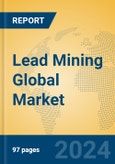Lead mining underpins a critical yet mature segment of the metals industry, extracting lead primarily for batteries, construction materials, and industrial applications, with a global resource base exceeding 2 billion tons. Significant deposits are associated with zinc, silver, and copper in countries like Australia, China, and Peru. In 2024, global refined lead production is forecast to rise by 2.4% to 13.5 million tons, while consumption edges up by 0.2% to 13.1 million tons, supported by secondary lead recovery, which accounts for 70% of U.S. consumption, largely from recycled batteries. The industry is marked by its reliance on recycling, stable demand from lead-acid batteries, and sensitivity to environmental regulations. Production in 2024 reflects a slight supply surplus, though long-term growth is constrained by substitution trends and health concerns.
This product will be delivered within 1-3 business days.
Market Size and Growth Forecast
The lead mining market is expected to achieve a valuation of USD 14-16 billion by 2025, with a modest CAGR of 0.1%-1% through 2030, reflecting stable battery demand offset by declining use in other applications and a shift toward secondary production.Regional Analysis
Asia Pacific, led by China, anticipates growth of 0.5%-1.5%, driven by battery manufacturing, though environmental policies curb primary mining expansion. South America, notably Peru and Mexico, expects growth of 0.2%-1%, supported by export markets, with trends emphasizing recycling integration. North America projects growth of 0.1%-0.8%, with the U.S. relying heavily on secondary lead, reflecting a mature market. Europe anticipates minimal growth of 0.1%-0.5%, constrained by strict regulations and declining industrial use. Australia expects growth of 0.2%-1%, leveraging its resource base for steady exports.Application Analysis
- Extraction of Lead: Projected at 0.1%-1%, this application focuses on battery production, with trends showing a sustained but slow growth due to EV battery alternatives.
Type Analysis
- Sphalerite Mining: Expected growth of 0.2%-1%, often co-mined with zinc, it remains a primary source, with trends toward efficient co-extraction.
- Willemite Mining: Anticipated at 0.1%-0.8%, this type is less prevalent, with niche growth tied to specific deposits.
- Calamine Mining: Projected at 0.1%-0.7%, it sees limited expansion due to lower lead content.
- Cerussite Mining: Expected at 0.1%-0.6%, this carbonate ore grows slowly, constrained by processing costs.
Key Market Players
- Glencore: A Swiss leader, Glencore excels in lead and zinc mining globally.
- Vedanta Resources: An Indian firm, Vedanta integrates lead with its diversified portfolio.
- Jiangxi Copper Corporation: A Chinese giant, it mines lead alongside copper.
- Nonfemet: A key player in lead extraction, focusing on regional markets.
- Yunnan Chihong Zn & Ge: A Chinese company, it combines lead with zinc operations.
- Teck Resources: A Canadian firm, Teck targets lead and other metals.
- Renco Group: An Italian player, Renco focuses on lead mining and processing.
- Gatos Silver: A U.S. company, it explores lead alongside silver.
- Buenaventura Mining: A Peruvian firm, it leverages rich deposits for export.
- Sierra Metals: A Canadian-South American player, it mines lead in multiple regions.
- South32: An Australian company, South32 diversifies into lead.
- Industrias Penoles: A Mexican firm, it leads in regional lead production.
- Boliden AB: A Swedish company, Boliden focuses on sustainable lead mining.
- BHP Billiton: An Australian giant, BHP includes lead in its portfolio.
- Henan Yuguang Gold and Lead: A Chinese firm, it dominates domestic lead supply.
Porter’s Five Forces Analysis
- Threat of New Entrants: Low. High barriers and environmental scrutiny limit entry.
- Threat of Substitutes: Moderate. Lithium batteries challenge lead-acid dominance.
- Bargaining Power of Buyers: Moderate. Battery makers have leverage, balanced by recycling supply.
- Bargaining Power of Suppliers: Moderate. Concentrated resources grant some power, tempered by secondary lead.
- Competitive Rivalry: Low to Moderate. Mature market reduces competition intensity.
Market Opportunities and Challenges
Opportunities
- Battery Demand: Lead-acid batteries sustain demand in automotive and backup power.
- Recycling Growth: Secondary lead expands supply options.
- Emerging Markets: Asia offers untapped potential.
- Stable Uses: Construction maintains baseline demand.
- Technological Advances: Improved recovery boosts efficiency.
Challenges
- Health Regulations: Lead’s toxicity drives stricter controls.
- Substitution Trends: Alternative batteries reduce primary need.
- Environmental Costs: Mining impacts raise compliance burdens.
- Supply Stability: Recycling reliance limits primary growth.
- Economic Cycles: Industrial slowdowns affect consumption.
This product will be delivered within 1-3 business days.
Table of Contents
Chapter 1 Executive SummaryChapter 2 Abbreviation and Acronyms
Chapter 3 Preface
Chapter 4 Market Landscape
Chapter 5 Market Trend Analysis
Chapter 6 Industry Chain Analysis
Chapter 7 Latest Market Dynamics
Chapter 8 Trading Analysis
Chapter 9 Historical and Forecast Lead Mining Market in North America (2020-2030)
Chapter 10 Historical and Forecast Lead Mining Market in South America (2020-2030)
Chapter 11 Historical and Forecast Lead Mining Market in Asia & Pacific (2020-2030)
Chapter 12 Historical and Forecast Lead Mining Market in Europe (2020-2030)
Chapter 13 Historical and Forecast Lead Mining Market in MEA (2020-2030)
Chapter 14 Summary For Global Lead Mining Market (2020-2025)
Chapter 15 Global Lead Mining Market Forecast (2025-2030)
Chapter 16 Analysis of Global Key Vendors
List of Tables and Figures
Companies Mentioned
- Glencore
- Vedanta Resources
- Jiangxi Copper Corporation
- Nonfemet
- Yunnan Chihong Zn & Ge
- Teck Resources
- Renco Group
- Gatos Silver
- Buenaventura Mining
- Sierra Metals
- South32
- Industrias Penoles
- Boliden AB
- BHP Billiton
- Henan Yuguang Gold and Lead








